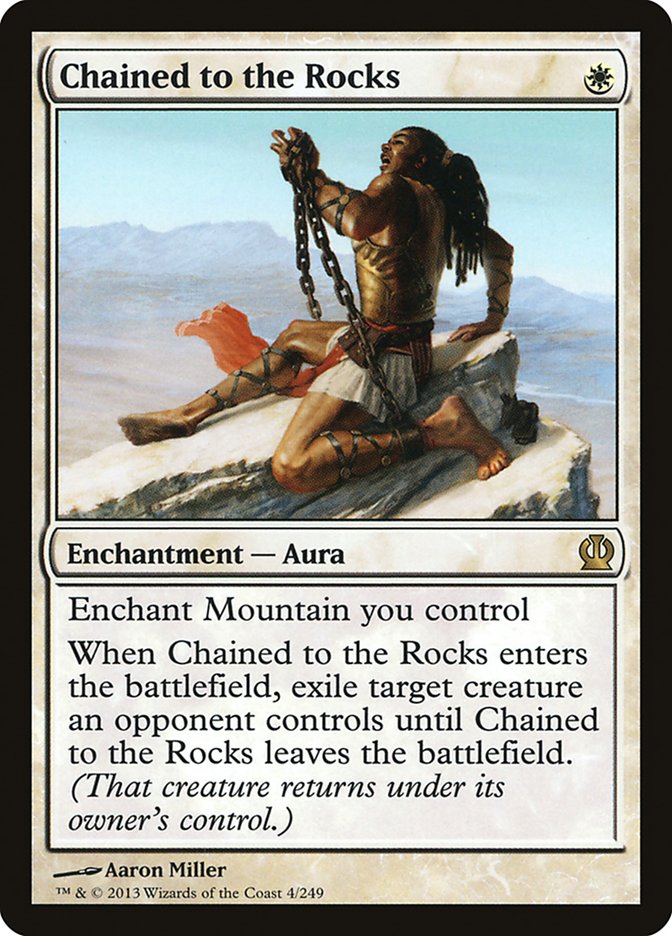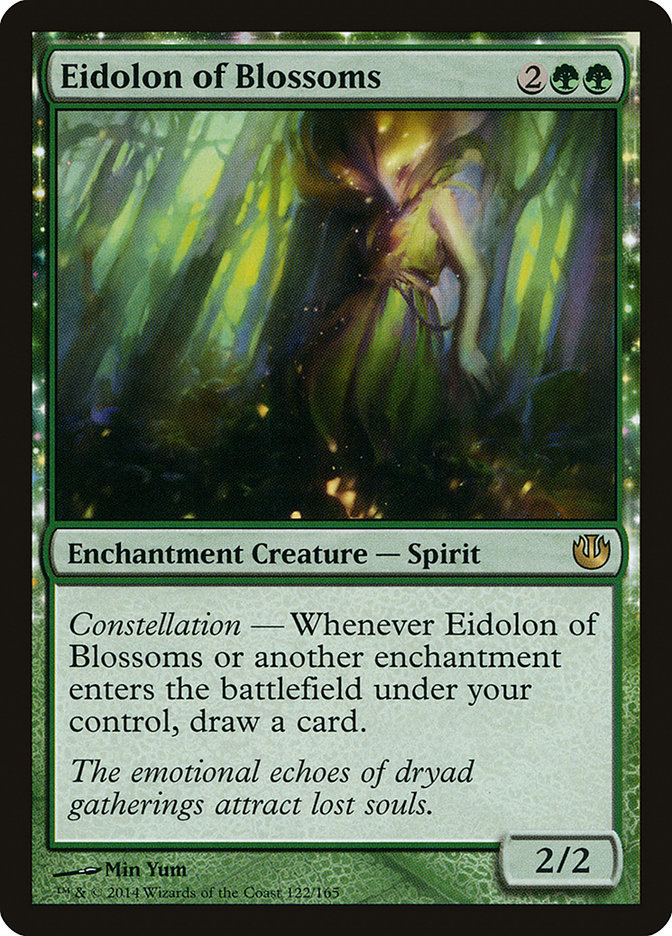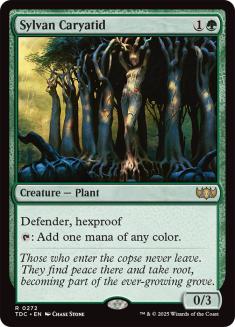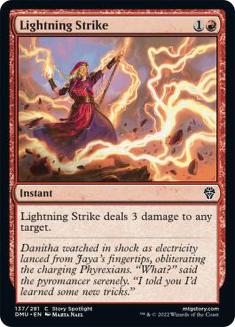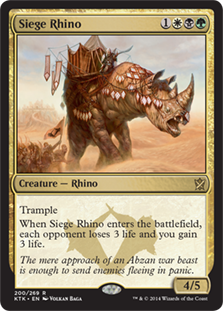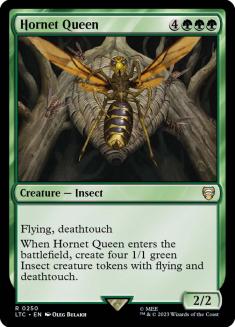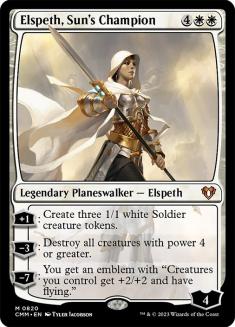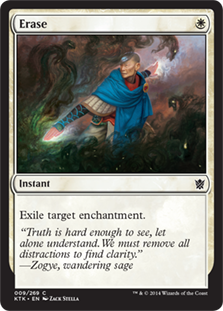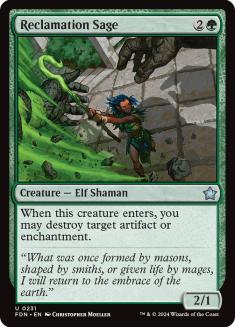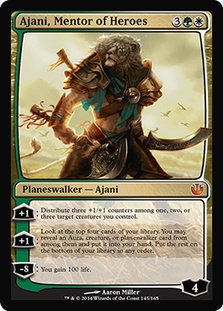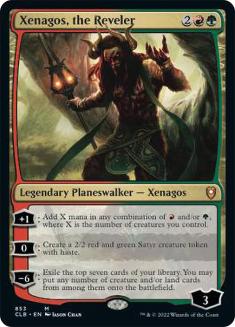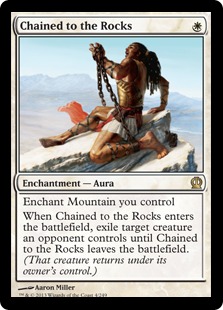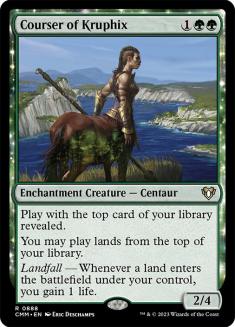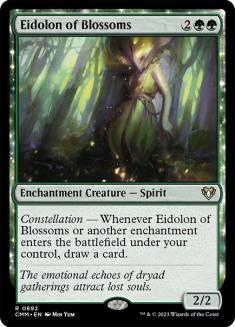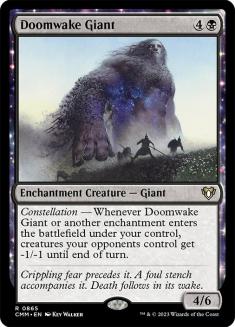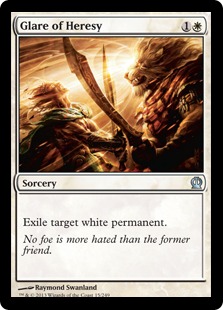This past week was one to remember. I got to end the year strong with a trophy and some much needed rest and relaxation with the family. I never really
knew how much stress I was under these past couple months until it was all said and done, but the work was definitely worth it. Food, conversations, and
sleep became my life while I was back in North Dakota. Celebrations were had and bellies were filled. I said goodbye to my parents and was on my way back
to Roanoke.
I was logged into Magic Online within minutes of getting home.
I can’t tell you how exciting it was to get back to Magic! I loved spending time with my family, but it was a surreal experience to just drop the game
hours after winning the tournament I spent months trying to qualify for. I got on the plane promising myself I wouldn’t think about competitive Magic
during the entire trip and I kept it.
All I wanted to do once I got home was figure out what I was going to play the next weekend. Standard has had some major shifts in the past couple weeks,
making it almost brand new to me. All the information gained in the time preparing for the Season Four Invitational and Players’ Championship was
practically left useless. I had to start all over!
For starters, Abzan Aggro is on a much needed rise. Andrew Tenjum and Thea Steele had very good finishes with the deck in the Standard Open at the Season
Four Invitiational, and Brian Braun-Duin further solidified the archetype with his top 4 finish in the Players’ Championship. Now almost half of the 4-0
lists from Magic Online have become this deck with many more filling out the 3-1s. Jeskai Tokens, on the other hand, has had a significant decline from its
break out performance in Worlds and SCG Portland. All of this makes sense but changes things significantly for the Reanimator fans who’ve seemed to be
moving over to the Sultai clan ever since the Players’ Championship.
On that note, I would like to say that most of the lists in the Players’ Championship were highly metagamed for the event. I would strongly consider
changing the lists to accommodate for an Open environment. This would be the list of Sultai Reanimator I would play if this article was, in fact, about
this deck and not one that is much sweeter.
Creatures (21)
- 2 Hornet Queen
- 4 Sylvan Caryatid
- 4 Courser of Kruphix
- 4 Satyr Wayfinder
- 2 Doomwake Giant
- 1 Soul of Innistrad
- 4 Sidisi, Brood Tyrant
Planeswalkers (2)
Lands (24)
Spells (13)

Sultai Reanimator isn’t actually the best deck for an open field. It is great when you expect a specific metagame, but the deck can’t be designed to beat
everything. Sidisi, Brood Tyrant isn’t as flexible as Siege Rhino, making it a deck that more things have to go right to win. You don’t just get to steal
as many games as Abzan decks do since more interaction needs to occur in almost every game you win. I only played that deck due to how good I felt it would
be for the Players’ Championship, I but have no interest picking it up again. That said, if you want to play Sultai Reanimator this weekend, I can happily
recommend that list.
I called up Todd Anderson to get his impressions of Standard since I’ve been out of it for so long, and he had an idea. He loved the shell of Chained to
the Rocks and Eidolon of Blossoms that Sam Black has been working on, but disliked many of the cards that came with the shell. I agreed with many of those
points and decided to change shells to see if I could find something that would work.
I’m not saying Sam’s deck is bad, since I’ve never tested it, but the reason I played Chained to the Rocks in Mardu and Four-Color Midrange was because I
wanted cheap and efficient removal in the lategame. I didn’t want to spend three more mana on my removal in the form of Heliod’s Pilgrim. I understand that
the body is relevant for triggering raid, but Wingmate Roc is also a card I haven’t liked that much. It just feels like a win-more card a lot of the time.
Sometimes it swings an unwinnable game into your favor, but off-curve the card just doesn’t do it for me.
I decided that the best shell for this interaction would be very similar to my old Four-Color Midrange deck that I built months ago. The only problem is
that the old version had a ton of ways to put pressure on an opponent. I don’t know if you know this, but Eidolon of Blossoms doesn’t play the role of
beatdown too well. Closing the games out would have to shift if the deck was going to find room for Eidolon of Blossoms.
Finding the way to win the games is the most crucial aspect to midrange decks in this format. So many decks have card advantage, removal, and great threats
that oftentimes things just bounce off of each other until someone has a threat that isn’t answered. This is mainly the reason that the format has
gravitated around Whip of Erebos and Hornet Queen for this long. In fact, this is probably the best win condition for a four-color shell that already wants
to play some number of Satyr Wayfinders to be able to find the Mountains needed for Chained to the Rocks.
Without further ado:
Creatures (24)
- 2 Hornet Queen
- 4 Sylvan Caryatid
- 4 Courser of Kruphix
- 4 Satyr Wayfinder
- 4 Eidolon of Blossoms
- 2 Doomwake Giant
- 4 Siege Rhino
Planeswalkers (1)
Lands (24)
Spells (11)

This list is a lot to take in, but initial testing has been amazing! The first iteration of Four-Color Midrange was a huge success in the understanding of
four-color manabases, but what I was doing with those colors wasn’t good enough. Reanimator strategies started taking over, making it almost impossible to
rely on that shell. Hornet Queen was simply too good.
Well if you can’t beat them…
The deck plays very similar to Abzan Reanimator, but the removal package is slightly different. Chained to the Rocks might seem like too much of a hassle
to be worth it, but the card is just unbelievably powerful. Abzan Reanimator has to rely so heavily on Murderous Cut for any type of tempo boost due to the
other removal spells costing three or more mana, but sometimes the graveyard just doesn’t have enough cards in it to not take up an entire turn to kill a
creature. That’s where Chained to the Rocks comes in. This one-mana removal spell allows the deck to more often resolve a threat along with a removal
spell.
The biggest benefit to splashing Chained to the Rocks comes in the form of Eidolon of Blossoms. The card advantage that is obtained by casting both of
these cards in the same turn is backbreaking. Just think about the games that your opponent taps out to play a threat and untaps to find there creature is
dead and their opponent has a must-kill creature without exhausting any cards in hand. Whipping back Eidolon of Blossoms also gets more potent when you
follow that up with the one mana removal spell.
Alright, I guess some of you might have some questions. Let’s see if I can guess them all so you won’t have to waste the time and can just start crushing
people with this deck.
Why two Lightning Strikes?
Lightning Strike might seem like it’s out of place, but decks like this want as much cheap removal as possible. With so many enters the battlefield tapped
lands and four-drops, you really need to be as efficient as possible with your removal spells. That said, Courser of Kruphix, Siege Rhino, Eidolon of
Blossoms, and Ajani, Mentor of Heroes all have one thing in common and that is they love being surrounded by removal spells. Most Whip-based decks want to
play about seven removal spells so their threat density doesn’t suffer, but this one thrives on having the ability to kill things and make the games go as
long as possible. This is the reason why you see zero copies of Thoughtseize in the maindeck.
Lightning Strike is simply just the best removal spell after Murderous Cut and Chained to the Rocks. It doesn’t kill everything, but that shouldn’t matter.
They could be Crackling Dooms, but the removal is only important when time is of the essence. This slot wouldn’t be removal if I wasn’t afraid of being run
over in the earlygame.
Only a single Mountain?
That’s right! A deck with four Chained to the Rocks that only runs one Mountain. To be honest, why would you want more? The deck runs no double red spells,
making the second one every game useless. Might as well just play a ton of fetchlands and hope you don’t play against Ashiok, Nightmare Weaver. And if
we’re being honest, that card is probably going to beat you regardless!
But what if you reveal it with Satyr Wayfinder? Aren’t you forced to take it then?
Yes, you are, and as you put it into your hand, you pat the little satyr on his head for doing his job!
I don’t know why I am still reading this article since there is no way I am going to play this. I know this isn’t a question, but I am still thinking
it.
You make a valid point, and I don’t have a good response.
Matchups
Before we get into each matchup specifically, I want to stress that this deck is like every other deck out there. Sequencing is crucial! I’ve never played
a Standard format like this one before, and honestly, I want to say this may be the most skill-intensive Standard format in some time. The games are all
long with a whole slew of complex decisions to be made. Never before have so many of my between round breaks revolved around discussing boardstates and
difficult plays. There are a ton of players that constantly complain about an opponent’s topdeck, yet every time I watch one of these games I am able to
point out a mistake made that would have mitigated the impact of said topdeck. You have to constantly be figuring out exactly how you are going to win the
game and not relying on a herd of rhinos to do the work for you.
VS Abzan/Sultai Reanimator
Even though these two decks run unique cards, the shells are very similar. They will have access to Pharika, God of Affliction and/or enchantment removal,
and we will have more removal and card advantage. Game 1 is much more difficult than post-sideboard, so the best course of action is to be aggressive.
Keeping Courser of Kruphix off the table is much more important in game 1 since they will have a strong lategame, but the added removal and card advantage
from Eidolon of Blossoms will help out significantly.
Out (on the draw VS Abzan Reanimator):
*Two copies of Doomwake Giant can be sideboarded out instead of two copies of Hornet Queen, depending on how they sideboard/what you saw in game 1.
In (on the draw VS Abzan Reanimator):
Out (on the play vs Abzan Reanimator):
*Two copies of Doomwake Giant can be sideboarded out instead of two copies of Hornet Queen depending on how they sideboard/what you saw in game 1.
In (on the play vs Abzan Reanimator):
Out (on the draw VS Sultai Reanimator):
In (on the draw VS Sultai Reanimator):
Out (on the play VS Sultai Reanimator):
In (on the play VS Sultai Reanimator):
So there are numerous talking points to go along with all of this. For starters, I hate Thoughtseize on the play against Whip of Erebos decks. There are
many players out there who will disagree with me, but I like to be proactive when I am on the play. I don’t want to draw a hand with too many reactive
cards and not be able to take advantage of the reason you are on the play in the first place. Thoughtseize plays an important role when on the draw since
you want to interact with your opponent as much as possible in the early stages of the game when you are on the draw, but deserves no love when you make
the first land drop.
Secondly, it is important to understand the Doomwake Giant and Hornet Queen song and dance. It is never always correct to keep them in or sideboard them
out. Their individual value is dependent on whether the opponent has the other one still in their deck. For example; you never want to have Hornet Queen in
your deck if they have Doomwake Giant, and you never want Doomwake Giant in your deck if they don’t have Hornet Queen in theirs. It isn’t the easiest to
guess and sometimes you will be wrong, but it is important to at least be thinking about it. When you are right, it can be the difference between winning
and losing. I often err on the side of caution and keep in Doomwake Giant while boarding out Hornet Queen when I am up against someone I don’t know, but I
will get frisky when I do know my opponent.
The last thing I want to mention about the Whip of Erebos mirrors is how important it is to choose a role and stick to it when sideboarding. I am a firm
believer that the person on the draw should play more controlling and the one on the play should be more aggressive. This may seem like the information
given would start a metagaming war, but sideboarding in these matchups isn’t the same as decks with wrath effects in the sideboard. The player who has a
board position first is advantaged, which means that the player on the draw should usually be disadvantaged if they have too many proactive elements in
their deck. This means you should just play to your outs and be the reactive player. This might hurt your chances of winning in the lategame, but at least
you got there.
VS W/U Heroic
The most important lesson to be learned about this matchup is that you do not need to play your removal as early as possible into open mana. Often times
they will draw some extra cards and have a protection spell. You can’t stop this. What you can stop is them being the only one with a board position. It is
important to develop your board while they are doing the same. Don’t engage in a fight unless you need to, and try to get into a position that is
favorable. Use the fact that they need to hold up a mana every turn to your advantage and start sticking permanents until the threat of dying next turn is
probable. This deck preys on fear, which means your win percentage will go up if you stop fearing it. You will lose matches to this deck sometimes because
their draw was fantastic, but you have to accept that. Once you do, you will start to lose less, and I promise that.
Out:
In:
I have considered not having any Sylvan Caryatids in my deck when I am on the play, but I’m not sure that a version with Eidolon of Blossoms can do that. I
really have only done that with Sultai Reanimator, but Abzan based versions can’t get away with it in the same way. Flooding is a real concern once you
have so much removal, but tempo is also key in the early turns. I’m not sold on this way of sideboarding, but it is what I’m most happy with currently.
VS Abzan Aggro
One of the benefits to transforming this archetype into an Eidolon of Blossoms shell is that Anafenza, the Foremost does not have as much of an impact on
your general strategy. You have more removal along with Siege Rhinos to hit them with a dose of their own medicine.
Out:
In:
Much like against W/U Heroic, you don’t want to lean on Sylvan Caryatid as much since you are bringing in so much removal. There will be so many cards
trading with each other that flooding in the mid-to-late game will be highly probable.
You’re on your own for the rest of the matchups. These three matchups are the most convoluted, which made me want to explain them, but the rest are fairly
straightforward. I’ve also thought long and hard on the idea of sideboard guides and found them to be highly disruptive in this format. Every deck has the
ability to shift just enough pieces around that having concrete plans is useless and often can lead to losses that were avoidable. I really wish I could
give the fish or even teach how to fish, but sideboarding is becoming so complex that each player has to learn how to do it themselves.
I suggest that instead of making sideboard guides, that you should research each deck in the format and try to understand how they all can and will
sideboard. This is something I have spent numerous hours on and one of the reasons I have such a high Standard win percentage. You need to know exactly
what each deck is capable of before you make a gameplan against them. This will help you understand how to be reactive when you need to be. Without that
background, you will have to lean too heavily on always being proactive.
I wish you all good luck this year. My season doesn’t start until next weekend when I head up to Philadelphia for the Legacy Open next weekend, but I hope
you all do well in Columbus this weekend!

